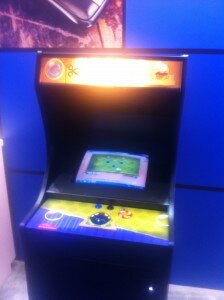CES 2012: The Return of Practical Tech
Posted by John Durbin | January 17, 2012
Last year was my first trip to CES and frankly, I was disappointed. Everything had to do with 3D. 3D TV’s, 3D video games, 3D without glasses, 3D energy conservation appliances. I found this development disappointing and surprising for three reasons.
- Our brains and eyes aren’t built for 3D.
- It’s not a new technology.
- Three is a good amount of reasons to have.
This year was a different story. I was amazed at the amount of practical technology that was being presented. Sure, there were still massive 3D displays (LG) but it felt more like a showroom floor where the theme is “we’ll make life better” as opposed to “isn’t this neat?”

"Cut the Rope" as arcade game. File under "Neat!"
Of course there was some opportunity to fall into each category. For example, TCL developed Dual Screen Television Technology. From one TV screen people can watch two different shows by wearing different glasses. Anyone who is married or shares a studio apartment (ew, seriously, find your own place) knows how useful this is. Now my wife can watch “Bridget Jones’s Diary” while I watch “Bridget Jones’s Diary 2: The Edge of Reason” from the same TV! (high five)
Casio demonstrated a watch that can sync with your smartphone. Someone calls you in a meeting and you can look at your watch to see who it is. Then awkwardly answer your phone. This is just one of many examples of device syncing that occurred all over the showroom floor but was definitely the most unique. Tapping into the cloud to sync was one of the bigger themes of CES 2012 whether that be syncing computing devices to save information or appliances to save energy. Tablets got a boost as they can now wirelessly connect to your TV. This is a big win for anyone who rents a movie through iTunes or just wants to experience a bigger display whilst playing Plants vs Zombies.
Despite the downplay on 3D, TV was still king of the show. This year just about every TV booth had a motion control TV. Which is great because now I don’t have to burn precious calories wandering my apartment looking for my remote. Technicolor displayed a panoramic TV technology that allows you to control the camera as you watch live sporting events. This was far more interesting than ESPN’s massive display pimping ESPN3D. Don’t get me wrong, ESPN staged a live boxing match and broadcast SportsNation from the show floor, which was super cool. But all of it was there to promote ESPN3D. Being able to point the camera wherever I want is far more appealing than feeling like Trent Richardson is coming right at me. The push of ESPN3D was interesting considering that a few months ago AT&T dropped it from it’s Uverse package. ESPN might be feeling the heat to recoup some of it’s high investment in the channel. My advice to ESPN? Ditch 3D as a separate channel and figure out a way to broadcast individual events in 3D on ESPN. Kinda like the way SAP or closed captioning works. Admission: I don’t know how SAP or closed captioning works.
Dish TV’s “Hopper” is a new set top box that has 2 terabytes of storage. This means you can record six HD shows while simultaneously recording four more HD shows. That sounds incredible. But as I walked by paper thin HD TV’s with unbelievable pictures, developing a box seems like a strange effort. I didn’t see any of the other major cable companies there, but they needed to be. They hold the keys to TV development now. Super thin TV’s are always going to look worse with a lot of wires sticking out or a box on a shelf nearby. AT&T has a new box that is wireless, which is a step in the right direction. But the first cable company who figures out how to stream their programming and push it onto the cloud is going to have the inside track in the cable race.

If you squint you can see a TV
This goes for video game console developers too. An XBox adds cables and wires and “stuff” next to a TV which hurts the overall aesthetics of the room. I don’t know the stats on it, but I am guessing a lot of gamers (15%?) are also renters and not in a position to drill a massive hole in their wall to install a wall mount. Of course of that 15% probably .03% are concerned with room aesthetics.
That’s not the only issue for game developers. I took some time to play EA’s Dead Space on the Samsung Galaxy Tablet. The Tablet was great. The game looked absolutely beautiful and was very responsive as I navigated through a spaceship with people impatiently looking over my shoulder. I did have some major issues, however, in trying to work the controls. It required swipes and taps and holding thumbs down in position. Overall, it was a very klunky gameplay experience. We’re very conditioned to use controllers and for deeper mobile gaming experiences, this is going to be critical. Companies are working on it, but it’s not here yet. In fact, given how prominent mobile and mobile accessories were this year, don’t be surprised to see some major tech players have some solutions to this at CES 2013 (assuming the Mayans were wrong). But until then, casual games or games designed specifically for tabs will dominate the marketplace.
There was no bigger sign (literally) as to the importance of mobile than Samsung’s promotion of it’s Galaxy Note.

The aforementioned sign. And yes, I will interrupt paragraph flow for a bad pun.
The Galaxy Note is a pocket sized tablet (bigger than a phone). It comes with a pen and is being positioned as taking on the role of a notebook you always take with you. To promote it, Samsung hired artists to draw caricatures of CES attendees on the Galaxy Note. Sounds kinda dorky, and I judged it pretty hard when I first saw, but it was pretty awesome. You could even get your caricature on a t-shirt. Which you should give to someone as a gift. There were several TV’s and mobile devices like the Galaxy note that came with pens for writing. Not unlike the Newton from the 90′s. Here’s the problem. If you have horrible handwriting (as I apparently do) it is a frustrating and pointless endeavor to try to take advantage of the writing capability on these devices. The thing that makes it all the more frustrating, especially the TV’s that could be “written” on, is that they make a lot of sense. They are very neat from a tech standpoint but also fill a void in our daily lives. Which is exactly what the tech industry needs to be doing and why this CES left me so optimistic for the future.

Caricatures on the Samsung Galaxy Note
A tip for anyone planning to go to CES next year: Go later in the day and later in the week. I was there Tuesday around lunchtime and it was a nightmare. It was so crowded that I not only gave up on trying to avoid running into people, I intentionally began running into people. But Thursday afternoon from about 3-6pm (the floor closes at 6) it was about as empty as you could expect it to be. I was able to move quickly around the floor and play with a lot of the devices that previously had lines 10 people deep. It was fantastic.
And with that practical advice, let’s open the floor. Anything not listed here you thought was especially nifty? Do you like 3D and I am just a curmudgeon? What do you predict will be the next big things based on what you saw? Did I run into you (sorry if I did)? Leave thoughts in the comments.
*Top Banner includes: Sony laptop that folds into a tablet, Art using headphones and paint by Jody Chestnut, Ford car that had doors that opened neat
One Response to “CES 2012: The Return of Practical Tech”
Leave a Comment
RSS feed for comments on this post · TrackBack URI


[...] Read about specific examples of both the cool and practical at his full post on Denuology. [...]